From way up in Jerusalem we zoomed way down past sea level to the lowest place on your planet, where the Jordan enters the Dead Sea.
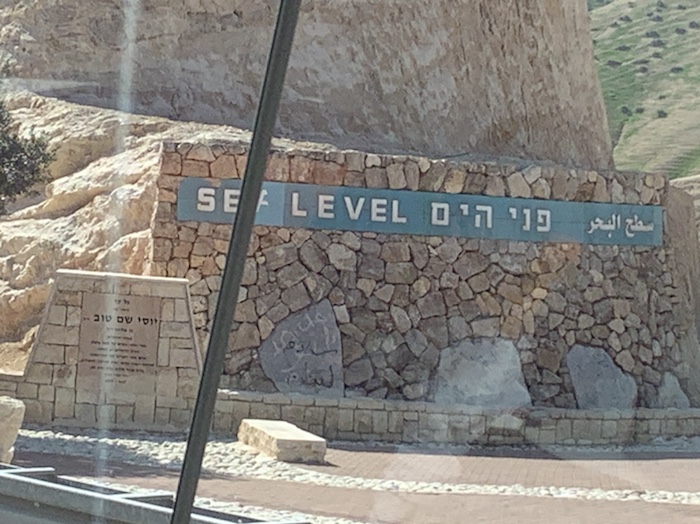
It was a short hike from there to the mountain where the Lord was tempted. I am struck by Benedict XVI’s reflection on this:
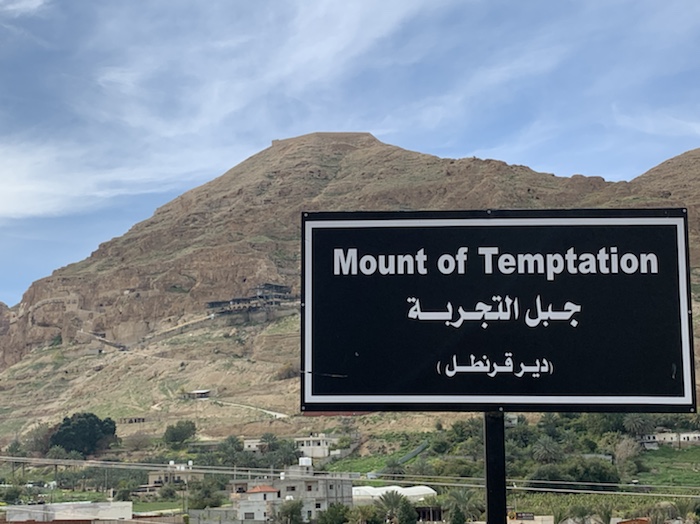
To Qumran, where the famous Dead Sea Scrolls were found, near the ruins of the community of the Essenes.
Cave 4 is where they found the scroll with the Book of Isaiah.
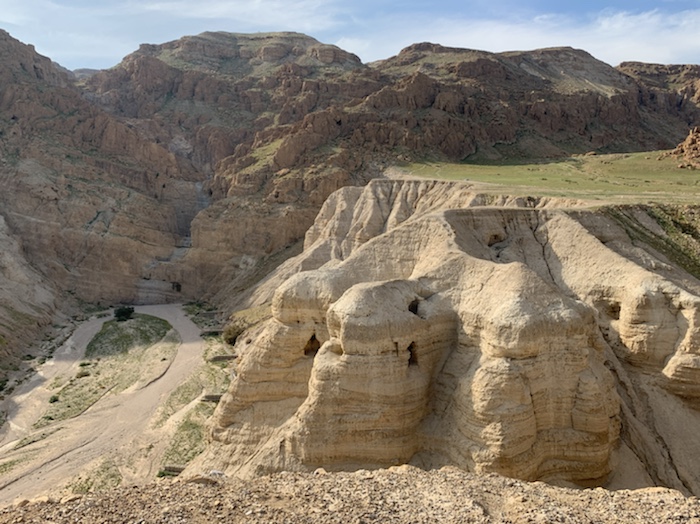
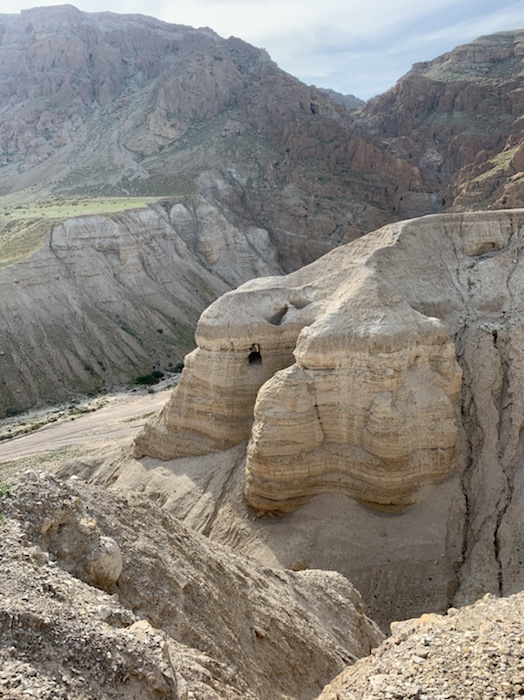
THE NEXT DAY…. EARLY O’CLOCK (we were out the door by 4:15.
On the way to the beginning of the Stations.
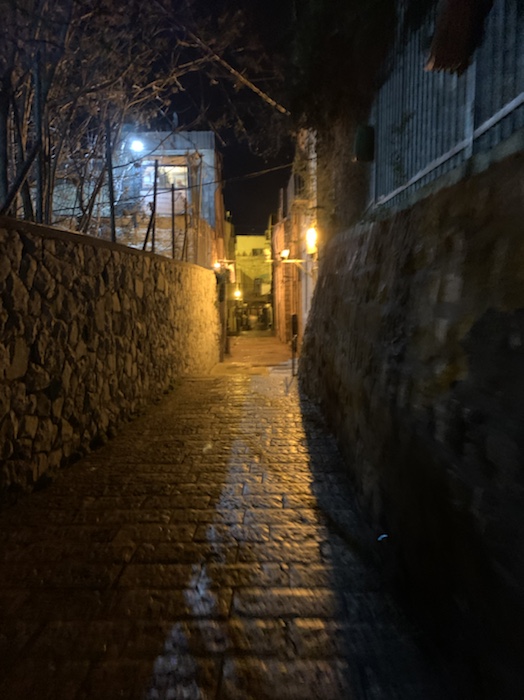
We used St. Alphonsus. My favorite.
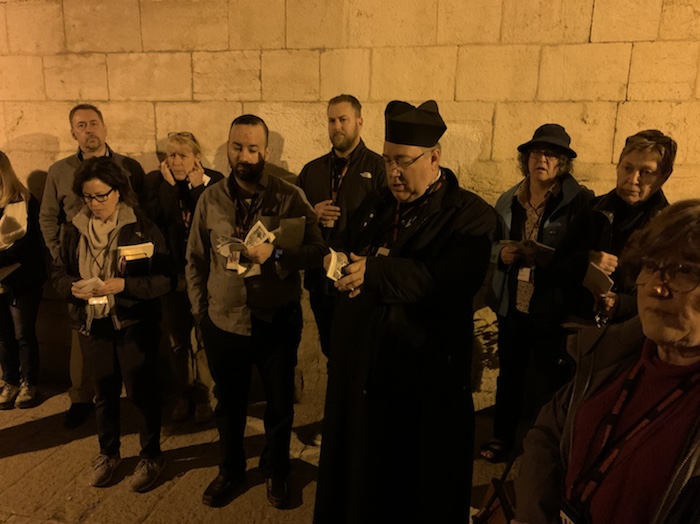
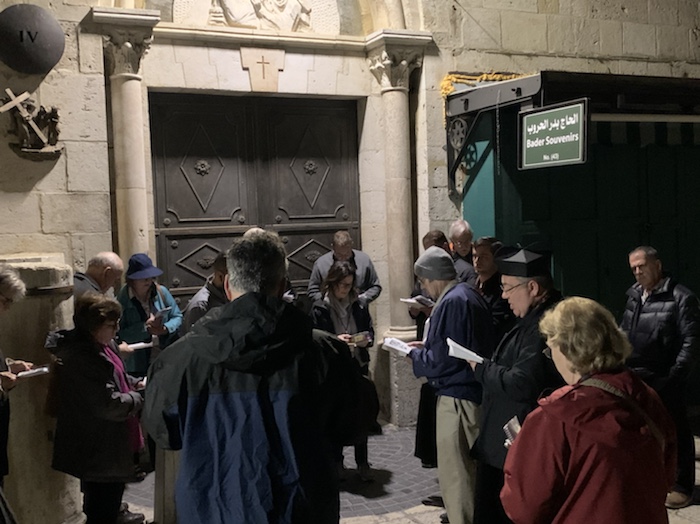
Moving inside the Basilica of the Holy Sepulcher we visited Golgotha, and the finished the Stations.
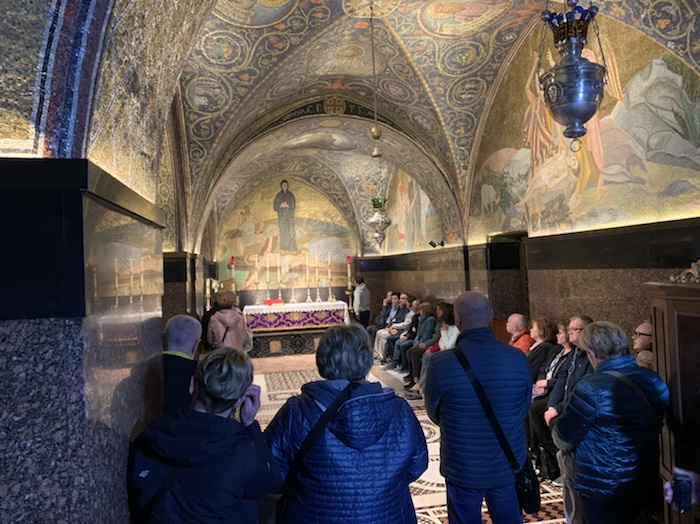
The place of the Crucifixion.
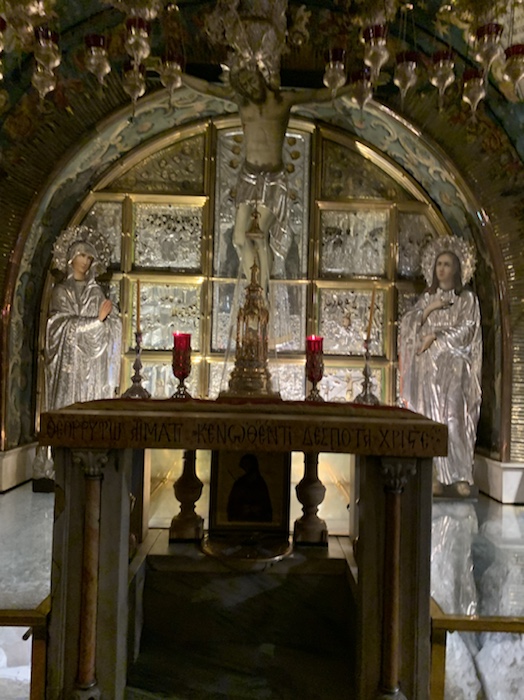
Soon after, vested, the server enters the chapel of the Tomb just before me.
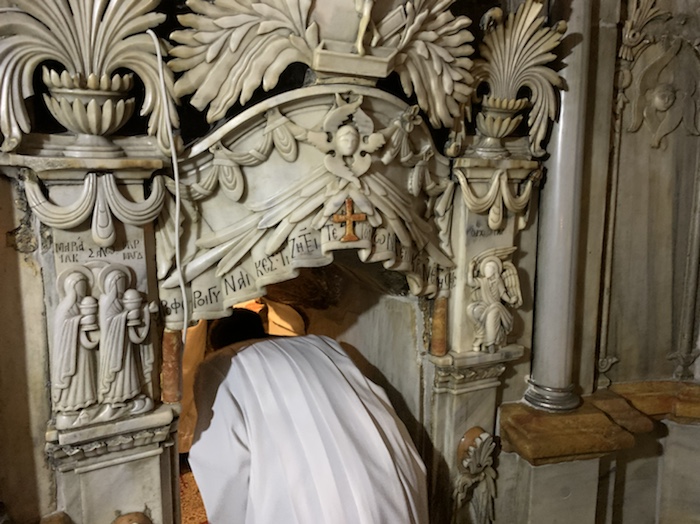
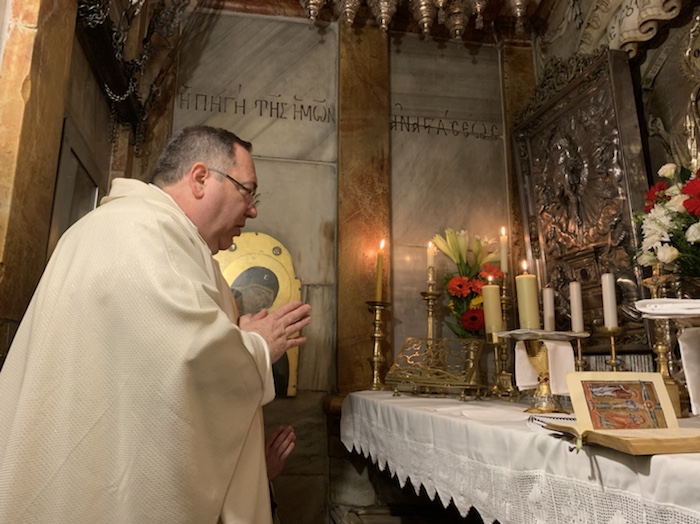
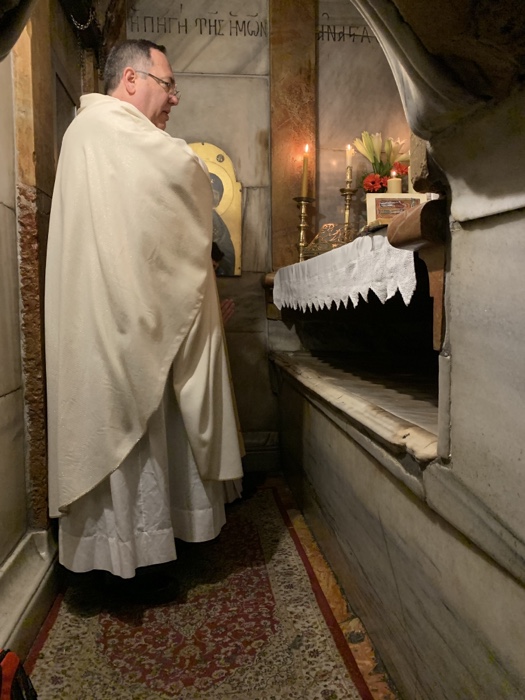
We had roughly 22 pilgrims, and 25 minutes for the Mass. Let’s just say that I moved rather quickly. NO… I didn’t use that chalice.
Here’s the note that hangs in the sacristy.
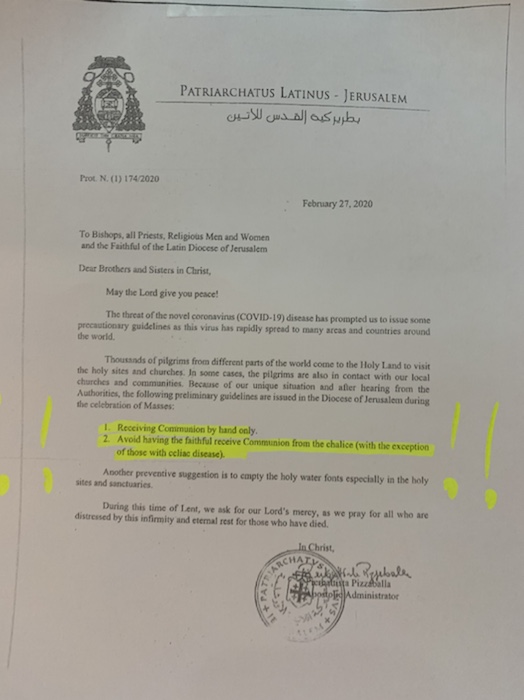
HAH HAH! HAH!
Outside, after.
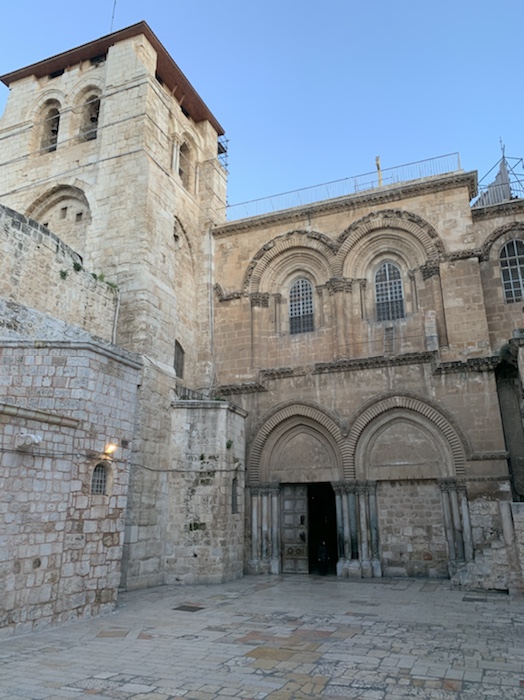


































Thanks, Father! Wonderful from beginning to end.
I heard somewhere that Golgotha is the same place where Abraham was asked to sacrifice Isaac. And If i’m not mistaken there was an older connection than that but I’m fuzzier on that memory so I won’t repeat it for fear of being wrong.
“Cave 4 is where they found the scroll with the Book of Isaiah.”
That’s just extremely remarkable to me. When reading scripture it’s easy to forget that someone had to write these out by hand, separately. They had to be stored somewhere. They had to be found. They had to be translated, assembled, bound, and preserved. I just can’t get over this. A part of me thought all these specific locations were lost to time. I had no idea. Thank you, First Christians, for remembering that we might remember. I should think the word to describe how these places were preserved is something like liturgy. If their rites didn’t treat these places as important, would we have them so well marked and preserved today?
The Scroll containing Isaiah. Absolutely incredible. I don’t know why that’s hitting me so hard.
Thank you for sharing!
scoot: The Qumran community at the Dead Sea where scrolls were discovered was likely Essenes which were a sect of Judaism. They were NOT Christians.
Traditionally, Eden’s holy mountain was in Jerusalem and the Holy Land. Adam was buried just outside it, and the site where Isaac was to be sacrificed was there too. And Golgotha.
The whole setup of salvation history in the Bible makes more sense when you realize where Eden is supposed to be. You have this whole OT cycle of longing to get back, getting closer and then getting thrown out for sin, and then coming back with new or expanded covenants, and then having the whole thing turned on its head in the NT, and the apostles getting assigned to go out all over the whole world again, in a somewhat different version of the original mission.somewhat
Fun stuff.
More on the Book of Isaiah found at the Dead Sea cave number one: it is the oldest, complete and nearly pristine copy of the Book of Isaiah in Hebrew ever discovered. It dates to c. 125 BC. Moreover, it is about 1000 years older than any complete biblical book in Hebrew previously known to scholars (Aleppo Codex c. 900 AD)!
Of the 930 individual documents discovered in the Qumran caves, approx. 25 percent (230 manuscripts) were “biblical” scrolls, the majority written in Hebrew, others in Aramaic and Greek. Every book of the Jewish bible is represented in the scrolls except Esther. The only complete book discovered was Isaiah.
What a profound experience it must have been, to offer Mass in the tomb of Our Lord!
“Communion in the mouth is certainly less dangerous and more hygienic compared to Communion in the hand. In fact, the palm and the fingers of the hand, without intense washing, undeniably contain an accumulation of viruses. … During the Church’s 2,000-year history there were no proven cases of contagion due to the reception of Holy Communion.” – Bishop Athanasius Schneider
Thank you Father. Your videos are fantastic!!
scoot: Ancient tradition identifies the threshing floor of Araunah the Jebusite (Cf. 2 Samuel 24. In 1 Chronicles 21 he is called Ornan) with the spot on which Abraham offered Isaac at the demand of the Lord. This sacrifice was begun but not completed and so from then on the name of the place was known as “God is watching”. This name indicates that God maintained His Presence on that spot in a special way. It is for this reason that the Angel of pestilence stops over this spot when he is accomplishing David’s punishment for the census.
Scripture tells us explicitly that this threshing floor becomes the floor of the Holy of Holies in Solomon’s temple. (Which is now under the Golden Dome of the Rock. Access to it is controlled by those who claim that it was Ishmael who was sacrificed there, not Isaac.)
This would mean that the place of Abraham’s sacrifice of Isaac was not Golgotha itself but the temple.
But recall that the Antonianum (Pilate’s palace) was built onto the outer wall of the temple.
This means that the distance of the place of Christ’s Sacrifice (Golgotha) from the place of Abraham’s sacrifice (The Holy of Holies) is measured by the Carrying of the Cross. (This always gives me matter for meditation when I lead the Stations of the Cross.)
And if we trace the etymology of Golgotha to Adam’s skull, Then we find Christ, the New Adam completing and fulfilling the sacrifices of both the First Adam and Isaac in the same place.
It gives layers of meaning to his “Consummatum est!”
From Op-Ed – Bishop Schneider: The Rite of Holy Communion in times of a pandemic:
‘The ban on Communion in the mouth is unfounded compared to the great health risks of Communion in the hand in the time of a pandemic. Such a ban constitutes an abuse of authority.’
What an outstanding experience to even observe. Thank you for taking us along and for great commentary. By the way, those are boss shades, Fr. Z.
Thanks for the correction, Fr. Kelly! That makes more sense than what I said.
Is the Dead Sea’s water level still really low?
“Now there was about this time Jesus, a wise man, if it be lawful to call him a man; for he was a doer of wonderful works, a teacher of such men as receive the truth with pleasure. He drew over to him both many of the Jews and many of the Gentiles. He was [the] Christ. And when Pilate, at the suggestion of the principal men amongst us, had condemned him to the cross, those that loved him at the first did not forsake him; for he appeared to them alive again the third day; as the divine prophets had foretold these and ten thousand other wonderful things concerning him. And the tribe of Christians, so named from him, are not extinct at this day.”
-Josephus, Antiquities of the Jews, 18.3.3
Scoot, acardnal, et al: The Shrine of the Book in Jerusalem displays many of the Dead Sea Scrolls including Isaiah. The museum architecture is partly based on a Qumran cave and scroll jar. There is also a large model of the Second Temple.
https://www.imj.org.il/en/wings/shrine-book/dead-sea-scrolls
Semper G: “…as the divine prophets had foretold these and ten thousand other wonderful things concerning him.”
Wow! I hadn’t come across that quote from Josephus before. Rather mirrors St. John 21.25 “the whole world could not contain all the books…”? Given that Josephus wrote around the same time, or shortly after, the Evangelist wrote his Gospel, it is amazing. Thanks.
Semper G: “…as the divine prophets had foretold these and ten thousand other wonderful things concerning him.”
Wow! I hadn’t come across that quote from Josephus before. Rather mirrors St. John 21.25 “the whole world could not contain all the books…”? Given that Josephus wrote around the same time, or shortly after, the Evangelist wrote his Gospel, it is amazing. Thanks.
Deus Meus! Forgive the double post, Fr. Dodgy connection:(
jaykay: You’re welcome. In addition to Josephus, maybe you already know this, Suetonius and Tacitus briefly wrote about Christians, “Chrestus” and Pontius Pilate.